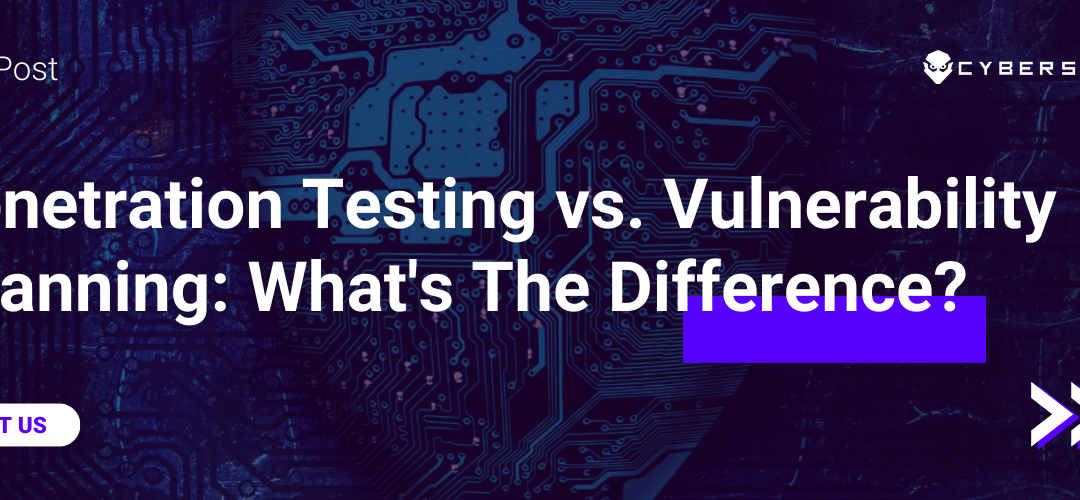The importance of having strong cybersecurity measures in place cannot be overstated. In today’s increasingly connected world, businesses are more vulnerable than ever to network breaches. A single breach can result in the loss of sensitive data, financial damage, and a tarnished reputation.
There are many different types of cybersecurity threats, and it can be difficult to know where to start when it comes to protecting your business. One of the first steps is understanding the difference between penetration testing and vulnerability scanning.
In this article, we will explore the benefits of penetration testing and vulnerability scanning and compare and contrast these two types of security assessments.
What Is a Vulnerability Scan?
Security vulnerabilities are weaknesses in the system that attackers can exploit. They can be found in many places, including operating systems, applications, and hardware.
A vulnerability scan is a process of locating and identifying these security vulnerabilities on a computer or network. It can be performed manually or with the help of automated tools. Vulnerability scans are typically conducted regularly, often as part of a larger network security audit or penetration testing.
Vulnerability scanning usually starts with a network discovery process, in which the scanner identifies all devices on the network. Once all devices have been identified, the scanner will check for known vulnerabilities. This is done by comparing the system’s configuration against a database of known vulnerabilities.
If any potential vulnerabilities are found, the scanner will generate a report that includes information on the vulnerability, its severity, and how to fix it.
There are several types of vulnerability scanning:
- Internal vulnerability scan: An internal scan is performed from within the network. This type of scan is used to identify vulnerabilities that could be exploited by someone who already has access to the network, such as a current or former employee.
- External vulnerability scan: An external scan is performed from outside the network. This type of scan is used to identify vulnerabilities that could be exploited by someone who does not have access to the network, such as a hacker.
- Environmental vulnerability scan: An environmental scan is used to identify vulnerabilities in the physical environment, such as servers located in a data center.
Vulnerability scans are an important part of any organization’s overall security program, as they can reduce the risk of a network breach. They can be done by internal IT staff or by external service providers.
What Are the Benefits of Vulnerability Scanning?
There are many benefits of vulnerability scanning, including:
- Reduced risk of a network breach: By identifying and patching vulnerabilities, organizations can reduce their risk of a network breach.
- Improved security posture: A comprehensive vulnerability scanning program can help improve an organization’s overall security posture. By identifying and patching vulnerabilities, organizations can reduce their risk of a network breach.
- Better compliance: There are many compliance standards, such as PCI DSS and HIPAA, that require vulnerability scanning to protect sensitive data. By conducting vulnerability scans regularly, organizations can ensure that they comply with these standards.
- Cost savings: Vulnerability scanning can help identify and prevent costly security incidents, saving organizations money in the long run.
- Early detection of attacks: Vulnerability scanning can help organizations detect attacks early before they cause serious damage.
What Are the Limitations of Vulnerability Scanning?
While vulnerability scanning is a valuable security tool, it has some limitations, including:
- Possibilities of false positives: Vulnerability scanners can produce false positives, which are reported vulnerabilities that are not actually present. This can waste time and resources as organizations investigate and patch non-existent vulnerabilities.
- Possibilities of false negatives: Vulnerability scanners can also produce false negatives, which are vulnerabilities that are present but not reported by the scanner. This can leave organizations open to attack if they rely solely on vulnerability scanning to identify weaknesses in their systems.
- Limited scope: Vulnerability scanners can only scan for known vulnerabilities. They cannot identify new or unknown vulnerabilities.
- Time and resources: Vulnerability scanning can be time-consuming and resource-intensive, especially for large organizations with multiple systems and networks.
Despite its limitations, vulnerability scanning is a valuable security tool that can help organizations reduce their risk of a network breach. By conducting regular scans and patching vulnerabilities, organizations can improve their security posture and compliance with regulatory requirements.
Vulnerability testing and penetration testing are two separate but related security testing methodologies. While both involve using automated tools to identify vulnerabilities in systems and networks, there are some key differences between the two.
What is Penetration Testing?
Penetration testing, also known as pen testing, is a type of security testing used to identify and exploit vulnerabilities in systems and networks. It is typically conducted manually by security experts.
Penetration tests are usually conducted on a one-time basis, although they can be conducted regularly as part of a larger network security audit or vulnerability testing program. They are often used to simulate a real-world attack on a system or network to identify vulnerabilities that attackers could exploit.
Penetration testing is more comprehensive than vulnerability testing. It identifies vulnerabilities and exploits them to see how far an attacker could potentially penetrate a system or network.
One of the main advantages of penetration testing is that it can help organizations assess the effectiveness of their security controls. By testing how well their systems and networks withstand an attack, they can identify weaknesses in their security posture and make improvements accordingly.
However, the disadvantage of penetration testing is that it is more expensive and time-consuming than vulnerability testing. It also requires a higher level of expertise and knowledge about exploiting vulnerabilities.
What is the Difference Between Vulnerability Testing and Penetration Testing?
The main difference between vulnerability testing and penetration testing is that penetration testing is more comprehensive than vulnerability testing. It identifies vulnerabilities and exploits them to see how far an attacker could potentially penetrate a system or network. Penetration testing is also more expensive than vulnerability testing.
Organizations should use both vulnerability testing and penetration testing as part of their overall security strategy to improve their security posture and reduce the risk of a network breach. While vulnerability scanning can help organizations identify vulnerabilities, penetration testing can help organizations identify and exploit vulnerabilities and thus improve the security of their systems and networks.
Contact Cyber Sainik Today
If you’re concerned about the security of your organization’s systems and networks, Cyber Sainik is here for you. We are a leading provider of information security services, including penetration testing and vulnerability scanning. Our services can help you assess your organization’s security posture and make improvements to reduce the risk of a network breach. Request for a free consultation today or contact us to learn more.




